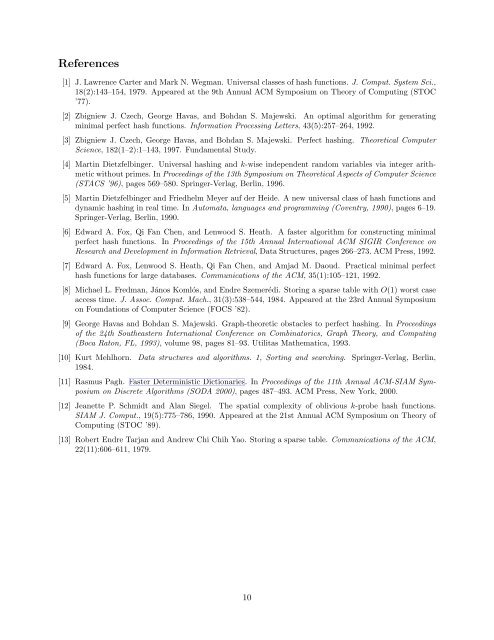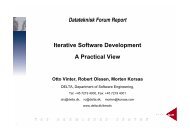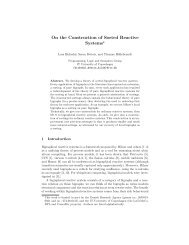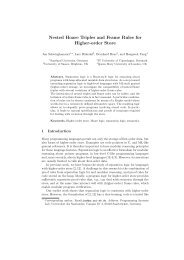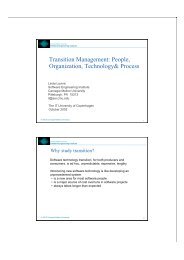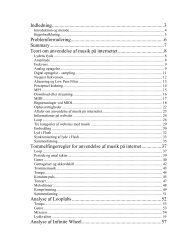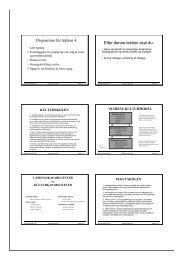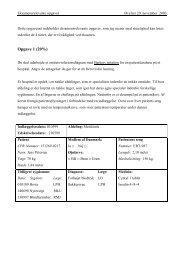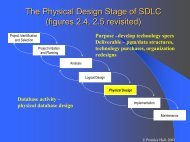Efficient Evaluation of Minimal Perfect Hash Functions
Efficient Evaluation of Minimal Perfect Hash Functions
Efficient Evaluation of Minimal Perfect Hash Functions
Create successful ePaper yourself
Turn your PDF publications into a flip-book with our unique Google optimized e-Paper software.
References[1] J. Lawrence Carter and Mark N. Wegman. Universal classes <strong>of</strong> hash functions. J. Comput. System Sci.,18(2):143–154, 1979. Appeared at the 9th Annual ACM Symposium on Theory <strong>of</strong> Computing (STOC’77).[2] Zbigniew J. Czech, George Havas, and Bohdan S. Majewski. An optimal algorithm for generatingminimal perfect hash functions. Information Processing Letters, 43(5):257–264, 1992.[3] Zbigniew J. Czech, George Havas, and Bohdan S. Majewski. <strong>Perfect</strong> hashing. Theoretical ComputerScience, 182(1–2):1–143, 1997. Fundamental Study.[4] Martin Dietzfelbinger. Universal hashing and k-wise independent random variables via integer arithmeticwithout primes. In Proceedings <strong>of</strong> the 13th Symposium on Theoretical Aspects <strong>of</strong> Computer Science(STACS ’96), pages 569–580. Springer-Verlag, Berlin, 1996.[5] Martin Dietzfelbinger and Friedhelm Meyer auf der Heide. A new universal class <strong>of</strong> hash functions anddynamic hashing in real time. In Automata, languages and programming (Coventry, 1990), pages 6–19.Springer-Verlag, Berlin, 1990.[6] Edward A. Fox, Qi Fan Chen, and Lenwood S. Heath. A faster algorithm for constructing minimalperfect hash functions. In Proceedings <strong>of</strong> the 15th Annual International ACM SIGIR Conference onResearch and Development in Information Retrieval, Data Structures, pages 266–273. ACM Press, 1992.[7] Edward A. Fox, Lenwood S. Heath, Qi Fan Chen, and Amjad M. Daoud. Practical minimal perfecthash functions for large databases. Communications <strong>of</strong> the ACM, 35(1):105–121, 1992.[8] Michael L. Fredman, János Komlós, and Endre Szemerédi. Storing a sparse table with O(1) worst caseaccess time. J. Assoc. Comput. Mach., 31(3):538–544, 1984. Appeared at the 23rd Annual Symposiumon Foundations <strong>of</strong> Computer Science (FOCS ’82).[9] George Havas and Bohdan S. Majewski. Graph-theoretic obstacles to perfect hashing. In Proceedings<strong>of</strong> the 24th Southeastern International Conference on Combinatorics, Graph Theory, and Computing(Boca Raton, FL, 1993), volume 98, pages 81–93. Utilitas Mathematica, 1993.[10] Kurt Mehlhorn. Data structures and algorithms. 1, Sorting and searching. Springer-Verlag, Berlin,1984.[11] Rasmus Pagh. Faster Deterministic Dictionaries. In Proceedings <strong>of</strong> the 11th Annual ACM-SIAM Symposiumon Discrete Algorithms (SODA 2000), pages 487–493. ACM Press, New York, 2000.[12] Jeanette P. Schmidt and Alan Siegel. The spatial complexity <strong>of</strong> oblivious k-probe hash functions.SIAM J. Comput., 19(5):775–786, 1990. Appeared at the 21st Annual ACM Symposium on Theory <strong>of</strong>Computing (STOC ’89).[13] Robert Endre Tarjan and Andrew Chi Chih Yao. Storing a sparse table. Communications <strong>of</strong> the ACM,22(11):606–611, 1979.10


